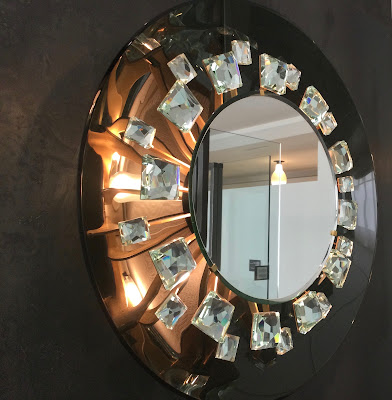%20photo%20by%20Cat%20Bauer.jpg) |
| Illuminated Mirror by Max Ingrand (1955) - Photo: Cat Bauer |
It is Italian design at its finest.
 |
| Curator Christian Larsen - Photo: Cat Bauer |
 |
| 'Teso' Bookcase by Renzo Piano (1987) - Photo: Cat Bauer |
Christian Larsen takes us on a journey through the Rooms of Glass with an overview of the creative production periods of FontanaArte's four great artistic directors:
- Gio Ponti: 1932-1933
- Pietro Chiesa: 1933-1948
- Max Ingrand: 1954-1967
- Gae Aulenti: 1979-1996
FontanaArte set the standards of Italian design by elevating the everyday object to the art of living. The exhibition kicks off with black and white excerpts from newsreels of industrial glass production in the 1930s when FontanaArte was in its infancy. It's fascinating to watch the early mechanical process with a human touch that resulted in the creation of plate glass. Larsen believes that when consumers understand the way that things are made, we will be a smarter consumers.
From there, the installation is laid out with each gallery focusing on the designs created under each artistic director, climaxing with a grand suite furnished to evoke a dwelling made of glass interiors with staging by architect Massimiliano Locatelli.
"A secret material, difficult to work with, but so noble and precious, glass seems to be the ideal complement to light, in which it plays by transmitting, by reflecting. It's a perfect combination."
---Max Ingrand
My favorite artistic director was Max Ingrand, whose designs had a touch of the spiritual added to their functionality. I absolutely loved his 1955 mirror embellished with cut crystals that catch the light and sparkle like diamonds, making whoever gazes at their own reflection more beautiful.
 |
| Grand Chandelier by Max Ingrand (1958) Photo courtesy of Le Stanze del Vetro |
Ingrand's Grand Chandelier was made for the 1958 Brussels World's Fair, and was one of the most complex and impressive of any work ever produced by FontanaArte. According to the exhibition, "With 32 bulbs housed in its brass and bronze structure, the cut crystal plates radiate light from the central core with the complexity of an intricately cut diamond."
The exhibition culminates in a 'house of glass,' a suite of galleries meant to evoke a domestic space furnished only with objects by FontanaArte. Massimiliano Locatelli's layout uses mirrors and glass to let us see through and across space, or get tangled up in reflections.
From the press release:
The house of glass has long been a dream of ideal architecture, since King Solomon's palace in the Bible, through to the technological solutions offered by modernist architects such as Taut, Careau, Mies van der Rohe, Johnson, Bo Bardi, and Frey. But it was the avant-garde vision of Luigi Fontana and Gio Ponti to reinvent industrial glass from an exterior construction material to a new luxurious standard for furnishing the interior of the home. To live not just encased in glass, but to live with glass.
FontanaArte. House of Glass curated by Christian Laresen is at Le Stanze del Vetro on the Island of San Giorgio Maggiore from April 4 to July 31, 2022. Go to Le Stanze del Vetro for more information.
Ciao from Venezia,
Cat Bauer
Venetian Cat - The Venice Blog



Designs from legendary FontanaArte in Milan, the company that elevated industrial plate glass to coveted home decor in the 20th century, is the focus of the spring exhibition at Le Stanze del Vetro (Rooms of Glass) on the Island of San Giorgio Maggiore. It is Italian design at its finest.
ReplyDelete